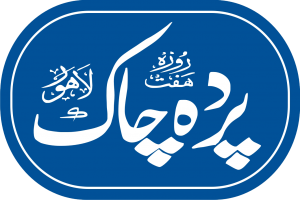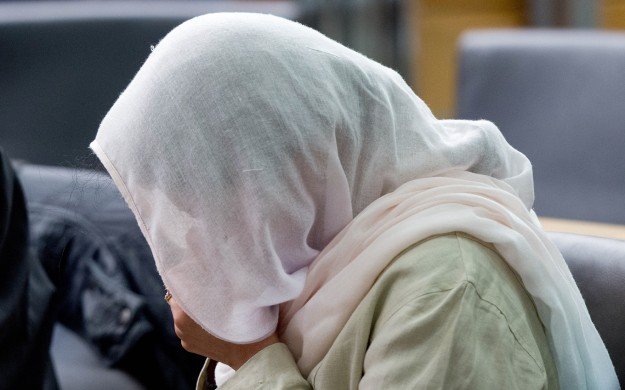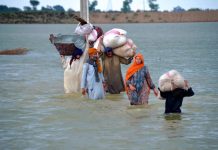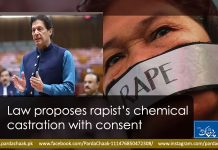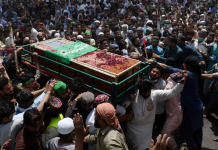While education is a useful resource to help establish financial independence, there are many other impediments that restrict the self-empowerment of women and leave them vulnerable to abuse.
Take the case of Salima: For almost two decades, Salima has worked as a cook. She lives with her abusive husband, an unemployed drug addict. Thanks to Salima’s job, the whole family lives in a tiny quarter usually reserved for factory workers in an industrial city in Punjab.
“Peace”, “safe”, that is what “Salima” means, but her name is a far cry from the reality of her existence. Salima has been married for over 25 years. Six years into her marriage, and two baby girls later, she finally gives birth to a baby boy. Zakia, the second daughter, is just ten months old when he is born. Laddoo (local sweets) are sent around the workers’ colony to celebrate the arrival of the first son.
The births of the eldest daughter and Zakia, were celebrated with sticky orange jalebi because laddoo are special. This is where it begins, with seemingly insignificant acts of discrimination. Discrimination against any segment of a community leads to the creation of the “other”. This group can then be legitimately attacked simply for being different.
Caring for three young children and a full-time job are too much for Salima, so Zakia is unceremoniously plucked from her mother’s arms and sent to her maternal grandparents’—the rationale being that she is too young to understand that her mother is now needed for the baby boy.
Zakia lives with her grandparents for almost 12 years. Then, not wanting to take on the responsibility of a menstruating girl, they send her back to Salima.
When she returns from school, Zakia joins her mother at work. She helps her cook and clean, then goes indoors, to find a quiet corner and do her schoolwork. The employer, an educator, promises to fund Zakia’s university education when she gets through high school. The bright young girl goes on to get teaching credentials and finds a job in a local school.
When Zakia starts working as a teacher, she dresses smartly and her confidence grows. Salima and her husband make the best choice they can from a pool of suitors, and within a year, Zakia is a married woman. Salima believes that her well educated, professional daughter has all the right tools to protect herself from potential domestic abuse.
Unfortunately, catering to the whims of the joint family, of which Zakia is now a member, is a challenge. She struggles to fit into the submissive role of a non-person in a new family. Her financial independence is a double-edged sword. The more her self-confidence grows, the less willing she is to submit to the unreasonable demands of her in-laws and her husband’s extended family. In the end, it is her ovaries that let her down.
Married life for most young women in this part of the world revolves around the ability to reproduce. Zakia has a hard time conceiving. Her in-laws believe it is because of the stress of her job. They pressure her to stop. She resigns. When she finally gives birth to a baby girl, she and her daughter immediately become “a burden” on her husband. Despite this stigma, she is not allowed to return to work.
At this point Zakia decides to start tutoring at home. The work, and the meagre income it brings, takes her mind off the day to day squabbles at home. She hangs a bed sheet over a wire to create a private space for herself and her students.
One day, when she is tutoring her neighbour’s daughter, she sees that the ‘curtain’ has not been fully drawn. This happens again the following week and a few more times after that. She suspects something is wrong because this only happens when her neighbour’s adolescent daughter is with her.
Zakia’s suspicions are confirmed one evening when she sees her husband’s hand slowly sliding the bed sheet to one side. When she glares at him accusingly, he is momentarily taken aback. However, his fragile ego can’t handle the embarrassment of being caught, especially in front of the girl he has been ogling. He grabs Zakia by the arm, throws her into the courtyard. Then, he starts beating her with the wooden stick used for washing clothes. None of the family members witnessing this abuse intervene.
The same day, Zakia moves back to her parents’ house —without her daughter. Her in-laws may not have wanted the baby girl, but she is their blood. If Zakia wants to be with her daughter, she will have to return to her husband.
Very often, the local community plays a major role in resolving cases of domestic violence. Both parties present their side of the case. The man responsible for sorting out the problem determines that Zakia’s husband is at fault. He gives Salima permission to beat him as much as she thinks necessary to ensure that her daughter has received justice. Salima knows that her daughter will bear the brunt of any action she takes now, so she puts a maternal hand on her son-in-law’s head, and publicly forgives him.
Salima hands Zakia back to her husband hoping that this time things will be different.
Statistically, the track record for reporting domestic violence is dismal:
“Most of the violence against women, particularly in the domestic sphere, goes unreported. Approximately 70-90% of Pakistani women in rural areas are subjected to violence. The female population in urban communities fare a little better.”
Despite the tireless effort of social workers and NGOs, the situation on the ground remains much the same for victims of gender-based violence. With issues ranging from the identification, apprehension, and castigation of perpetrators, to the healing of traumatised victims and their reintegration into society as healthy individuals, the challenges are enormous. The recent case in Gujranwala is a perfect example of spousal abuse.
While access to opportunities for self-empowerment such as education, public transport, and a wider range of employment opportunities makes life a little easier for women and girls in urban areas, their lives are still far from perfect. Take the cases of domestic violence in Sindh which have increased during the COVID-19 pandemic. The Advocacy Brief on Gender and Pandemic Urgent Call for Action published in April, 2020 by the United Nations, is another stark reminder of how the situation for victims of domestic abuse has only deteriorated during the pandemic.
Many of us know Salimas and Zakias with other names who face similar challenges. The story of these two women is in no way unique.
The questions we need to ask ourselves are,
Was Zakia’s abuser being consciously protected by the rest of the family? What would the repercussions for Zakia or Salima be if they were to leave their abusers? Would they be blamed and shamed? Do the other females of the family walk on eggshells around an abusive family member to ensure their own safety? How much control do any of the females in these homes have over their own bodies? How can these vulnerable women and girls be protected in the private spaces of their own homes?
And most importantly, how did Zakia end up in the same place as her mother? Her life started off on a path which was believed to be the best way forward. Education, the way to self-empowerment and financial independence.
Who is to blame for the situation in which Zakia finds herself? Her mother, for pulling her down to her own level of helplessness? Her abusive husband? Her in-laws and the extended family? Her neighbours? The government for failing to provide the necessary infrastructure for the safety of the female population? Who?
Of course, one might be tempted to blame everyone who directly or indirectly participated in Zakia’s abuse. But, I believe that the situation is more complex than that.
The ideology that leads to the subjugation of females in our society, and the sources that promote it, needs to be re-examined. What messages are being expounded by the “talking-heads” on our national media? Which organizations support these ideas disseminated by these so-called ‘scholars’ and ‘experts’? Who stands to benefit from these ideas? It is certainly not our women and girls.
The actions, and the inaction, of all the characters in Zakia’s life are only the symptoms of the disease. The disease itself is the ideology that supports the degradation of basic human rights of our women and girls. It is this ideology that needs to change if we really want to empower the whole population of the nation and bring about real change.
